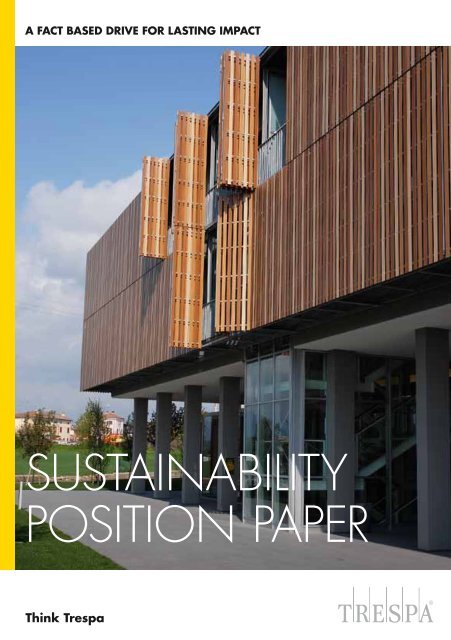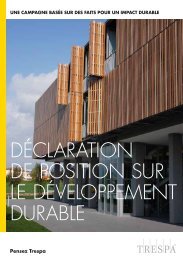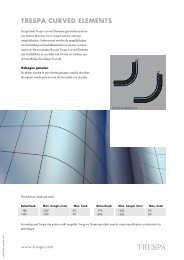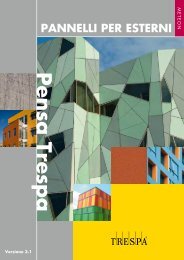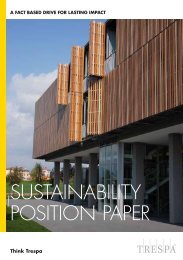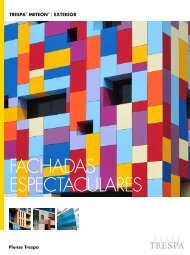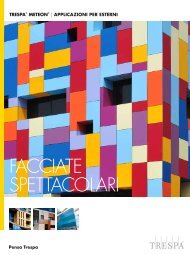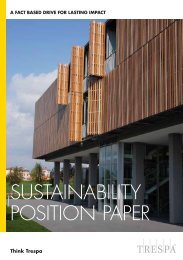SUSTAINABILITY POSITION PAPER - Trespa
SUSTAINABILITY POSITION PAPER - Trespa
SUSTAINABILITY POSITION PAPER - Trespa
- No tags were found...
Create successful ePaper yourself
Turn your PDF publications into a flip-book with our unique Google optimized e-Paper software.
Development”. 1 We have selected “TheEnvironment” as a starting point for oursustainability efforts, which contains thefollowing four topics:■■■■Prevention of pollutionSustainable resource useClimate change mitigation andadaptationProtection and restorationof the natural environmentThis paper is the second position paperproduced and published by <strong>Trespa</strong> anddescribes the initial results and sets thenext targets on the journey to improvesustainability performance. During the lasttwo years significant achievements havebeen made at improving the accuracy of dataand at reducing waste and energy.To assess the impact of these achievements,a new LCA (Life Cycle Assessment) hasbeen performed by PE International in thefirst months of 2012. <strong>Trespa</strong> decided tocommunicate the conclusions of this secondLCA, progress achieved so far and a new setof targets in this second position paper.As new results or more information becomesavailable, <strong>Trespa</strong> will restate its positionagain and accordingly issue a new versionof this position paper. In doing so, <strong>Trespa</strong>will clearly outline its progress as well as thechange in its priorities.1 For more information about the ISO 26000 norm, see Appendix 1and http://www.iso.org/iso/home/standards/iso26000.htm3
1 Philosophy and beliefsSustainable development provides <strong>Trespa</strong> withchallenges as well as new opportunitiesCommon senseAs in many of its business decisions <strong>Trespa</strong>will use common sense in addressingthe topic of sustainable development.This implies avoidance of philosophiesand dogmas and choosing to base thesustainability strategy on measurementof environmental impacts.Objective and fact based<strong>Trespa</strong> believes in objective and fact basedanalysis and has performed an LCA tomap its environmental footprint along theentire value chain. Though many differentmethods exist, <strong>Trespa</strong> believes that the LCA,as described in ISO 14040 and ISO 14044,is currently the most objective and factbased method to measure its environmentalfootprint that is available. This is supportedby an increasing number of certificationsrelying on this methodology. Althoughit will pursue certification, this is not thebackbone of <strong>Trespa</strong>’s sustainability policy.The LCA for <strong>Trespa</strong> has been performed andvalidated by one of the leading consultantsin the area of sustainable development,and will form the basis for all of <strong>Trespa</strong>’simprovement initiatives. However, <strong>Trespa</strong>will continue to monitor alternativeavailable methodologies and adopt onesthat are understandable, transparent andstandardized and that promote lastingimprovements.Integral part of business planningand review cycleTo achieve change <strong>Trespa</strong> will set prioritiesbased on its LCA and agree to realisticbut challenging targets. In line with otherLicense to Operate topics, <strong>Trespa</strong> hasintegrated all sustainability issues intoits rolling business planning and reviewcycle. This cycle consists of annual targetsetting in the budgeting round, a monthlymanagement review of progress againstKPIs and inclusion of sustainability in theannual report.4
2 Sustainability PolicyThe basis of <strong>Trespa</strong>’s sustainability policy is astrong belief that any change should startwith the company itself.Do No Harm<strong>Trespa</strong>’s first task is to comply withthe safety, product and sustainabilityregulations and guidelines set by thecountries in which it operates.In addition, <strong>Trespa</strong> is looking foropportunities to minimize the impactof its operations and products.Do BetterFinally, <strong>Trespa</strong> believes that investingin sustainable development should bebeneficial to the long term position of thecompany. Many sustainability challengesconstitute opportunities that make goodbusiness sense today and will allow thecompany to continue to grow.Do GoodThe second element of <strong>Trespa</strong>’s policy is thatit strives to help its suppliers and customersrealize their sustainability challenges. Thismeans that <strong>Trespa</strong> looks for opportunitiesto maximize the sustainability contributionof its products in the value chain, includingtheir end-use, e.g. façade cladding.Moreover, <strong>Trespa</strong> will continue to look foropportunities and initiatives to supportand promote longer term sustainabledevelopment beyond the direct scope of itscurrent operations.5
3 ProgressImproving information from 2009to 2011 Life Cycle AssessmentThe 2009 LCA led to three clear focal pointsfor <strong>Trespa</strong>’s sustainability efforts. For eachof those focal points, <strong>Trespa</strong> communicatedtargets in the previous position paper.The focal points were:1. Upstream contributions from rawmaterial production and transport2. Onsite emissions originating fromresin production and impregnation3. Primary energy use for <strong>Trespa</strong>’s ownproduction processesIn performing the 2009 LCA <strong>Trespa</strong> came tothe conclusion that it needed more detailedinformation on each of these topics inorder to successfully address them. For thisreason, <strong>Trespa</strong> started a dialogue with itsKraft paper suppliers to get more detailedinformation on material and energy usageduring the Kraft paper production process.While the process of gathering more data isstill on-going, detailed information has beenreceived from some major suppliers, whichshows the original assumptions to be poor.These new, more specific data have beenincorporated in the 2011 LCA.Internally, <strong>Trespa</strong> put a lot of effort inimproving the accuracy of the mass andenergy balances. This led to an improvedinsight into material usage and wastereduction opportunities. As a result, therelative waste production has been reducedby more than 10% during the first half of2012.Although no targets have been set for onsiteemissions, new information enabled <strong>Trespa</strong>to improve its environmental profile.As a specific action, acetone as a solventwas removed from the production process.Furthermore, all refrigeration and coolingequipment containing the R22 cooling agenthas been replaced.Regarding the third focal point, a detailedenergy balance was established for the <strong>Trespa</strong>manufacturing process, including a monthlyelectricity and gas consumption overview.This led to improved insight in energyusage and consequently, the relative energyconsumption has been reduced by more than3% since the previous position paper.6
As a specific action, high energy consumingcomputers in the plant have been replacedby low energy satellites and a high energyconsuming server has been switched off.Also regarding steam consumption, moredetailed, equipment specific, informationwas gathered and tracked on a monthlybasis. This led to a plan to install highefficiency steam boilers and increasethe recovery of off gas heat from theimpregnation off gas burner, which will beexecuted in the near future. The next chartshows the trend of the relative electricityconsumption, gas consumption and wastegenerated. Finally, the PEFC chain-ofcustodycertificate has been achieved, whichis part of <strong>Trespa</strong>’s responsible sourcingstrategy.110105RELATIVE INDEXED ENERGYCONSUMPTION AND <strong>PAPER</strong>WASTE GENEARTION(KWH/TON, M3/TONOR KG/TON)100959085REL. ELECTRICITY CONS.REL. GAS CONS.2009 2010 2011100 96,5 97,0100 107,9 108,1REL. <strong>PAPER</strong> WASTE 10095,0 100,87
4 Measuringenvironmental impactA second LCA of <strong>Trespa</strong>, based on fullyear 2011 data, has been carried out in thefirst months of 2012 with the help of PEInternational, a leading consultant inthis area.The LCA has been performed from a ‘cradleto-gate’perspective that basically looks at thetotal impact of the manufacturing footprintincluding the extraction and processingof raw materials as well as transport to themanufacturing site for all products producedby <strong>Trespa</strong>. The results are presented in thetable below. The units are based on theproduction of 1 ton of <strong>Trespa</strong> HPL. Theanalysis excludes the effects during theuse and end of life phase which have to beanalysed on a specific product level.Six key environmental indicators commonlyagreed to as most relevant were selected byPE International based on their inclusionin Environmental Product Declarations(EPDs). EPD’s are the leading documents topublish sustainability results. Based on the2009 LCA results, <strong>Trespa</strong> is finalizing EPDsaccording to the French (FDES), German(IBU) and British (BREEAM) standard.The LCA parameters included in EPDs coveremissions of substances with a negativeimpact on the environment (air, water andsoil), emissions of greenhouse gases thatcontribute to climate change and depletionof energy resources both non-renewable andrenewable. These indicators are listed andexplained in Appendix 2.Per ton HPLEnvironmentalimpactdimensionsUnitstotal2009 lcatotal2011 lcarawmaterialcontributiontrespacontributionAcidification (AP) Kg SO 2-Equiv. 5.6 10 85% 15%Emissions toair, waterand soilEutrophication (EP) Kg P-Equiv. 0.88 1.10 75% 25%Ozone Depletion Potential(ODP)Kg R11-Equiv. 8.5E-05 8.9E-05 99% 1%Photochemical Ozonecreation (POCP)Kg Ethene-Equiv. 0.85 1.02 72% 28%Primary energyconsumptionand carbonfootprintTotal PrimaryEnergyGJ 65 73.3 63% 37%Carbon footprint (GWP) Kg CO 2-Equiv. 900 1560 39% 61%Renewableenergy share% 29 27 97% 3%8
The 2011 LCA is updated with more accurateinformation on the environmental profile ofthe paper used in the manufacture of <strong>Trespa</strong>HPL. The generic Kraft paper data usedpreviously was replaced with the saturatedKraft core paper data from a leading supplierto <strong>Trespa</strong>. This paper was found to have asignificant higher environmental impactthan the Kraft liner paper values used in the2009 LCA, as can be concluded from theabovementioned table. <strong>Trespa</strong> is expectingto receive Kraft paper data from othersuppliers at the end of 2012 as well, afterwhich the 2011 LCA results will be updatedaccordingly.In the following diagram the relativecontribution of the different steps fromcradle to gate is presented.Based on these results, PE Internationalmade the following recommendations:■ Complete the data collection from Kraftpaper suppliers; utilize the data to makea more sustainable paper choice andto engage Kraft paper suppliers intoenvironmental improvement actions.■ Shift the core material from paper towood chips. Initiate a discussion withchips supplier to potentially collect datafrom them.PE’s recommendations have been takeninto account when <strong>Trespa</strong> set the newimprovement initiatives outlined in the nextparagraph.POCPEPAPODPPRODUCTION OFRAW MATERIALSPRODUCTION OFENERGY AND FUELS (OFFSITE)TRANSPORTEMISSIONS ON SITEWASTE TREATMENTGWP0% 20% 40% 60% 80% 100%Cradle to gate9
5 Improvement Initiatives2013 - 2015Reduction of upstream contributionsand primary energy consumptionAs the 2012 LCA clearly indicates,the impact of the raw materials on<strong>Trespa</strong>’s environmental profile increasedsignificantly. The second biggest factor isand remains the use of primary energy onsite. Therefore, the improvement initiatives2013-2015 are aimed at:■ Upstream contributions from rawmaterial production and transport.■ Primary energy use for <strong>Trespa</strong>’s ownproduction processes.To ensure progress and positive impacton <strong>Trespa</strong>’s environmental profile and thusLCA, <strong>Trespa</strong> has added the following list oftargets to its business planning:Reduction of upstream contributions:■ Reduction of the relative amount of waste(in kg/ton <strong>Trespa</strong> HPL) by 15% at the endof 2015 compared to end of 2011.■ Further detail the specific contributionsof Kraft paper with <strong>Trespa</strong>’s suppliersand get into dialogue to reduce theirenvironmental impact.■ Detail the specific contributions ofchemicals and of woodchips with<strong>Trespa</strong>’s suppliers.Reduction of primary energyconsumption:■ In line with the Multiyear agreement ofthe Dutch government with the industry,<strong>Trespa</strong> aims at reducing the relativeenergy consumption (in GJ/ton <strong>Trespa</strong>HPL) by 8% at the end of 2015 comparedto end of 2011. Amongst others, thisincludes replacing all lights in the factoryand in the offices by LED lights.In addition to these operational targets,<strong>Trespa</strong> will focus on implementing theproper certification required in the market,such as FSC or PEFC certification.To assess the impact of these initiatives andto include new information, <strong>Trespa</strong> intendsto perform a new LCA in 2014, based on fullyear 2013 data.10
Guidance on Social Responsibility from ISO 26000including the priority areasCore subjects and issuesAdressed in sub-clauseCore subject: Organizational governance 6.2Decision-making processes and structures 6.2.3Core subject: Human rights 6.2Issue 1: Due diligence 6.3.3Issue 2: Human rights risk situations 6.3.4Issue 3: Avoidance of complicity 6.3.5Issue 4: Resolving grievances 6.3.6Issue 5: Discrimination and vulnerable groups 6.3.7Issue 6: Civil and political rights 6.3.8Issue 7: Economic, social and cultural rights 6.3.9Issue 8: Fundamental rights at work 6.3.10Core subject: Labour Practices 6.4Issue 1: Employment and employment relationships 6.4.3Issue 2: Conditions of work and social protection 6.4.4Issue 3: Social dialogue 6.4.5Issue 5: Human development and training in the workplace 6.4.7Core subject: The environment 6.5Issue 1: Prevention of pollution 6.5.3Issue 2: Sustainable resource use 6.5.4Issue 3: Climate change mitigation and adaptation 6.5.5Issue 4: Protection and restorationof the natural environment6.5.612
Core subject: Fair operating practices 6.6Issue 1: Anti–corruption 6.6.3Issue 2: Responsible political involvement 6.6.4Issue 3: Fair competition 6.6.5Issue 4: Promoting social responsibility in the sphere of influence 6.6.6Issue 5: Respect for property rights 6.6.7Core subject: Consumer issues 6.7Issue 1: Fair marketing, information and contractual practices 6.7.3Issue 2: Protecting consumers’ health and safety 6.7.4Issue 3: Sustainable consumption 6.7.5Issue 4: Consumer service, support, and dispute resolution 6.7.6Issue 5: Consumer data protection and privacy 6.7.7Issue 6: Access to essential services 6.7.8Issue 7: Education and awareness 6.7.9Core subject: Community involvement and development 6.8Issue 1: Community involvement 6.8.3Issue 2: Education and culture 6.8.4Issue 3: Employment creation and skills development 6.8.5Issue 4: Technology development 6.8.6Issue 5: Wealth and income creation 6.8.7Issue 6: Health 6.8.8Issue 7: Social investment 6.8.913
APPENDIX 2LCA environmental indicatorsEmissions parametersAcidification Potential (AP) gauging the effect of releasing acids into environment ultimatelyleading to phenomena like acid rainEutrophication Potential (EP) measuring the effect of releasing excessive amounts ofnutrients into surface water which reduces the oxygen content in the water and kills aquatic life.Ozone Depletion Potential (ODP) measuring the effects of gas emissions ultimately leadingto breaks in the earth’s protective ozone layer with all the associated detrimental effects on life.Well-known but fortunately banned contributors to ozone depletion are CFC gasses.Photochemical Ozone Creation Potential (POCP) gauging the emissions of gasses withnegative impact on the local environment resulting in the buildup of summer smog.Climate change parametersGlobal Warming Potential (GWP) is the emission of greenhouse gasses leading to climatechange. This dimension is also known as the carbon footprint and is measured in equivalentemission of carbon dioxide. Burning fossil fuels is the major source of GWP, but carbon capturein raw materials such as wood can off-set these emissions.Resource depletion parametersPrimary energy usage is the energy required to produce one unit of product.Share of renewable energy providing the share of energy coming from renewable sourceslike sun and wind.14
DISCLAIMERGeneralThese terms apply to the use of this document and such use automaticallymeans that the other party agrees to these terms. The informationprovided by <strong>Trespa</strong> International B.V. (“<strong>Trespa</strong>”) in this documentis solely indicative. <strong>Trespa</strong> is unable to warrant the accuracy andcompleteness of this information. <strong>Trespa</strong> may change the informationincluded in this document at any time and without further notice.<strong>Trespa</strong>’s customers and third parties must ascertain that they have themost recent document (for the most recent version, please consult: www.trespa.com). No rights can be derived from the information provided;the use of the information is at the other party’s risk and responsibility.<strong>Trespa</strong> does not warrant that the information in this document issuitable for the purpose for which it is consulted by the other party. Thisdocument does not contain any design, structural calculation, estimateor other warranty or representation that customers and third partiesmay rely on. This document does not guarantee any properties of <strong>Trespa</strong>products. Colours used in <strong>Trespa</strong>’s communications (including butnot limited to printed matter) and in samples of <strong>Trespa</strong>’s products maydiffer from the colours of the <strong>Trespa</strong> products to be supplied. Samplesare not intended for use in product tests and are not representative ofcharacteristics of the <strong>Trespa</strong> products. <strong>Trespa</strong>’s products and samplesare produced within the specified colour tolerances and the colours (ofproduction batches) may differ, even if the same colour is used. Theviewing angle also influences the colour perception. Metallics panelsfeature a surface whose colour appears to change based on the directionfrom which it is viewed. The specified colour stability and colourspecifications relate only to the decorative surface of the <strong>Trespa</strong> products,not to the core material and samples of the <strong>Trespa</strong> products. <strong>Trespa</strong>products are delivered ex-works with straight, sawn sides. Customersand third parties must have a professional adviser inform them about(the suitability of) the <strong>Trespa</strong> products for all desired applications andabout applicable laws and regulations. <strong>Trespa</strong> does not warrant the above.The most recent version of the current delivery programme and theMaterial Properties Datasheet can be found at www.trespa.info. Only theinformation in the most recent and valid Material Properties Datasheetshould be used to select and provide advice regarding <strong>Trespa</strong> products.<strong>Trespa</strong> reserves the right to change (the specifications for) its productswithout prior notice.Liability<strong>Trespa</strong> is not liable (neither contractual nor non-contractual) for anydamage arising from or related to the use of this document, except ifand to the extent that such damage is the result of wilful misconductor gross negligence on the part of <strong>Trespa</strong> and/or its management. Thelimitation of liability applies to all parties affiliated with <strong>Trespa</strong>, includingbut not limited to its officers, directors, employees, affiliated enterprises,suppliers, distributors, agents, and representatives.General conditionsAll oral and written statements, offers, quotations, sales, supplies,deliveries and/or agreements and all related activities of <strong>Trespa</strong> aregoverned by the <strong>Trespa</strong> General Terms and Conditions of Sale (Algemeneverkoopvoorwaarden <strong>Trespa</strong> International B.V.) filed with the Chamber ofCommerce and Industry for Noord- en Midden- Limburg in Venlo (NL)on 11 April 2007 under number 24270677, which can be found on anddownloaded from the <strong>Trespa</strong> website, www.trespa.com/documentation.All oral and written statements, offers, quotations, sales, supplies,deliveries and/or agreements and all related work of <strong>Trespa</strong> NorthAmerica, Ltd. are governed by the <strong>Trespa</strong> North America General Termsand Conditions of Sale, which can be found on and downloaded fromthe <strong>Trespa</strong> website, www.trespa.com/documentation. A copy of thesegeneral conditions of sale will be provided free of charge on request.All general terms and conditions other than the conditions mentionedabove are dismissed and do not apply, regardless of whether such termsand conditions are referred to on requests for offers, offer confirmations,stationery and/or other documents of the other party, even if <strong>Trespa</strong> doesnot expressly object to such terms and conditions.Intellectual propertyAll intellectual property rights and other rights regarding the contentof this document (including logos, text and photographs) are owned by<strong>Trespa</strong> and/or its licensors. Any use of the content of this document,including distribution, reproduction, disclosure, storage in an automateddata file or the dispatch of such a file without <strong>Trespa</strong>’s prior writtenconsent is explicitly prohibited. ® <strong>Trespa</strong>, Meteon, Athlon, TopLab,TopLab PLUS , TopLab ECO-FIBRE , Virtuon, Volkern, <strong>Trespa</strong> Essentials andMystic Metallics are registered trademarks of <strong>Trespa</strong>.QuestionsShould you have any questions or comments, please do not hesitate tocontact <strong>Trespa</strong>.15
CONTACT USVISIT US<strong>Trespa</strong> International B.V.P.O. Box 110, 6000 AC WeertWetering 20, 6002 SM WeertThe Netherlandswww.trespa.comCustomer Service DeskEMEA ExportTel: +31 (0) 495 458 359 / 573Fax: +31 (0) 495 458 383Info.Export@<strong>Trespa</strong>.comCustomer Service DeskThe NetherlandsTel: +31 (0) 495 458 850Fax: +31 (0) 495 540 535Info.Nederland@<strong>Trespa</strong>.com<strong>Trespa</strong> Belgium bvba/SprlH. van Veldekesingel 150 B. 193500 HasseltBelgiumTel: 0800 15501Fax: 0800 15503Info.Belgium@<strong>Trespa</strong>.comGrand Duché de LuxembourgTel: +31 (0) 495 458 308<strong>Trespa</strong> Deutschland gmbhEuropaallee 2750226 FrechenGermanyTel: 0800 186 04 22Fax: 0800 186 07 33Info.Deutschland@<strong>Trespa</strong>.com<strong>Trespa</strong> UK Ltd.Grosvenor HouseHollinswood RoadCentral Park, TelfordShropshire, TF2 9TWUnited KingdomTel: +44 (0) 1952 290707Fax: +44 (0) 1952 290101Info.UK@<strong>Trespa</strong>.com<strong>Trespa</strong> France s.a.r.l.14 Place Georges Pompidou78180 Montigny-le-BretonneuxFranceTel: +33 (0) 1 34 98 16 67Fax: +33 (0) 1 34 98 16 68Info.France@<strong>Trespa</strong>.com<strong>Trespa</strong> IberiaCalle Ribera 5,08003 BarcelonaSpainTel: +34 (0) 93 315 04 47Fax: +34 (0) 93 516 02 12Info.Iberia@<strong>Trespa</strong>.com<strong>Trespa</strong> North America Ltd.62 Greene Street (Ground Floor)New York, NY 10012United States of AmericaTel: +1 800 487 3772Fax: +1 866 298 3499Info.NorthAmerica@<strong>Trespa</strong>.com<strong>Trespa</strong> Chile Ltda.Eliodoro Yáñez 2831Torre A - Local 1Providencia, SantiagoChileTel: +56 2 4069990Info.Chile@<strong>Trespa</strong>.comHigh Quality Panelss. de R.L de C.V.Avenida Pablo Neruda 2278,Colonia ProvidenciaGuadalajara, JaliscoMéxico CP 44630Tel: +52 (33) 12020189 /12020250Fax: +52 (33) 12020189info@highqualitypanels.com<strong>Trespa</strong> China Co. ltd.Room 2604-05, HuaiHai PlazaNo. 1045 HuaiHai Road (central)ShangHai 200031P.R. ChinaTel: +86 (0) 21 6288 1299Fax: +86 (0) 21 6288 1296Info.China@<strong>Trespa</strong>.comCustomer Service DeskAsia/PacificTel: +86 (0) 21 5465 8388Fax: +86 (0) 21 5465 6989Info.APAC@<strong>Trespa</strong>.com<strong>Trespa</strong> Design CentreNew York62 Greene Street (Ground Floor)New York, NY 10012United States of AmericaTel: +1 212 334 6888Fax: +1 866 298 3499TDC.NewYork@<strong>Trespa</strong>.comwww.trespa.com/tdc<strong>Trespa</strong> Design CentreWeertWetering 206002 SM WeertThe NetherlandsTel: +31 (0) 495 458 845TDC.Weert@<strong>Trespa</strong>.comwww.trespa.com/tdc<strong>Trespa</strong> Design CentreBarcelonaCalle Ribera 5,08003 BarcelonaSpainTel: +34 (0) 93 295 4193Fax: +34 (0) 93 116 3300TDC.Barcelona@<strong>Trespa</strong>.comwww.trespa.com/tdc<strong>Trespa</strong> Design CentreSantiagoEliodoro Yáñez 2831Torre A - Local 1Providencia, SantiagoChileTel: +56 2 4069990TDC.Santiago@<strong>Trespa</strong>.comwww.trespa.com/tdcVersion 2.0 ■ brochure Code U2501 ■ Date 11-2012visit trespa.com for the mostup to date version of this document.


